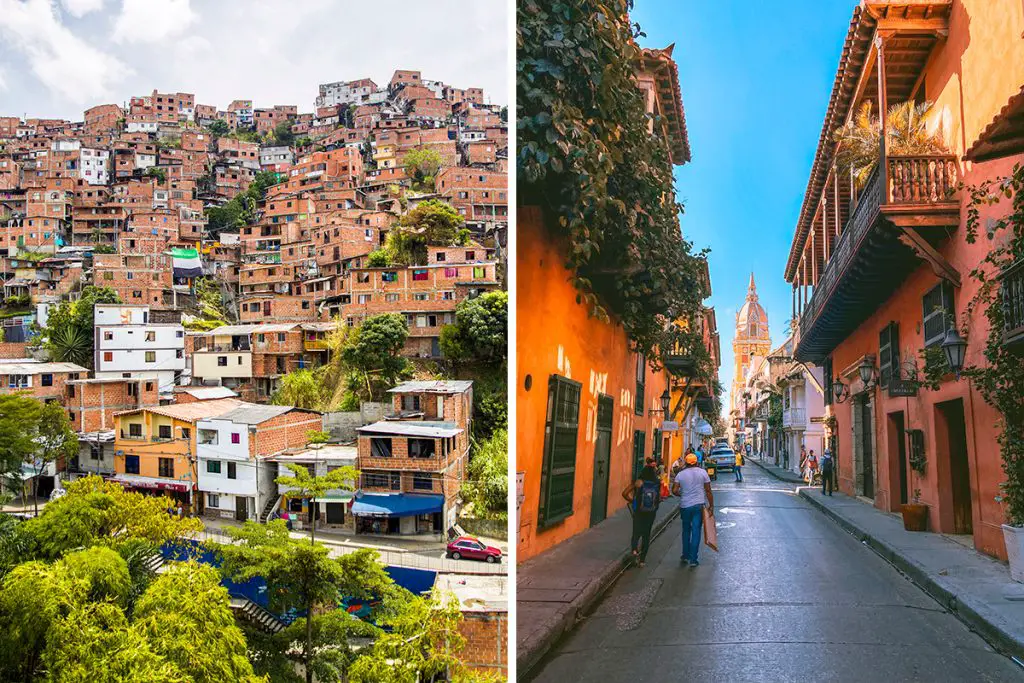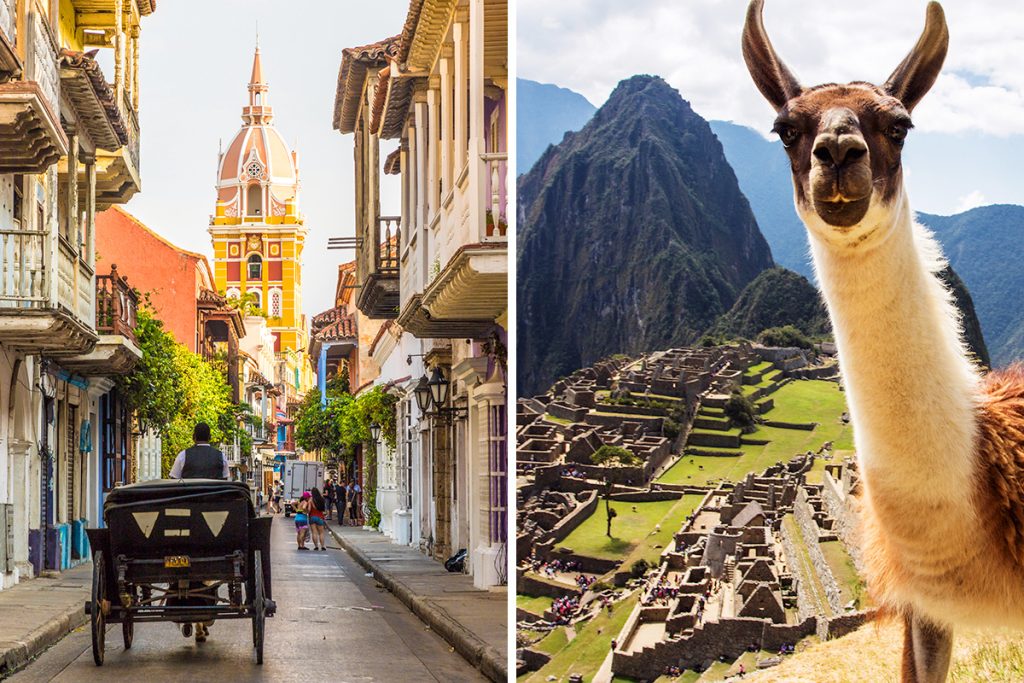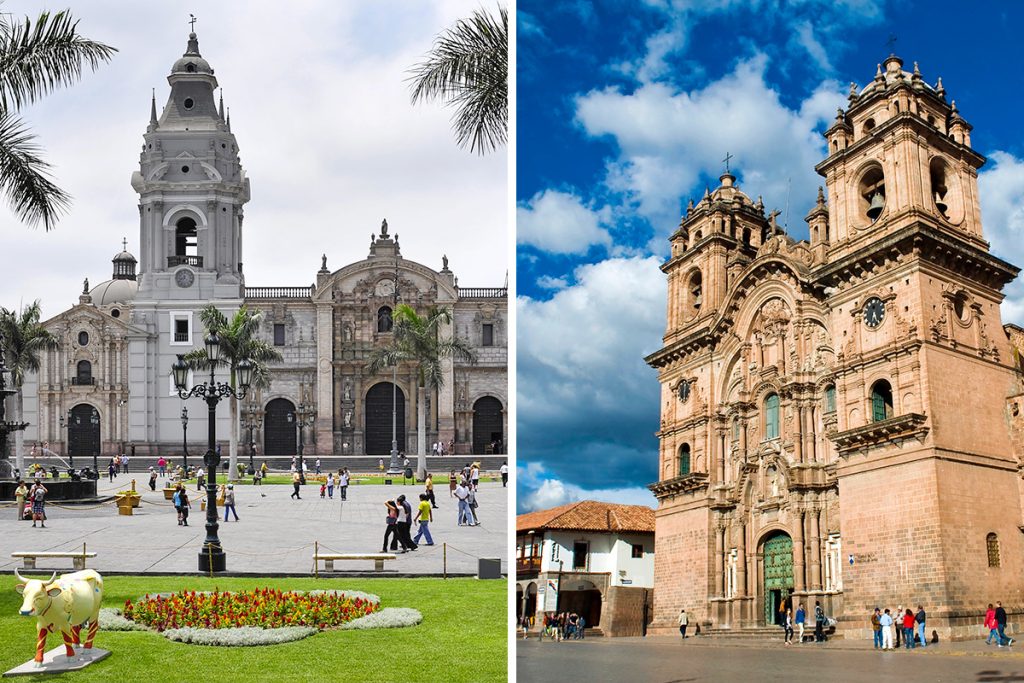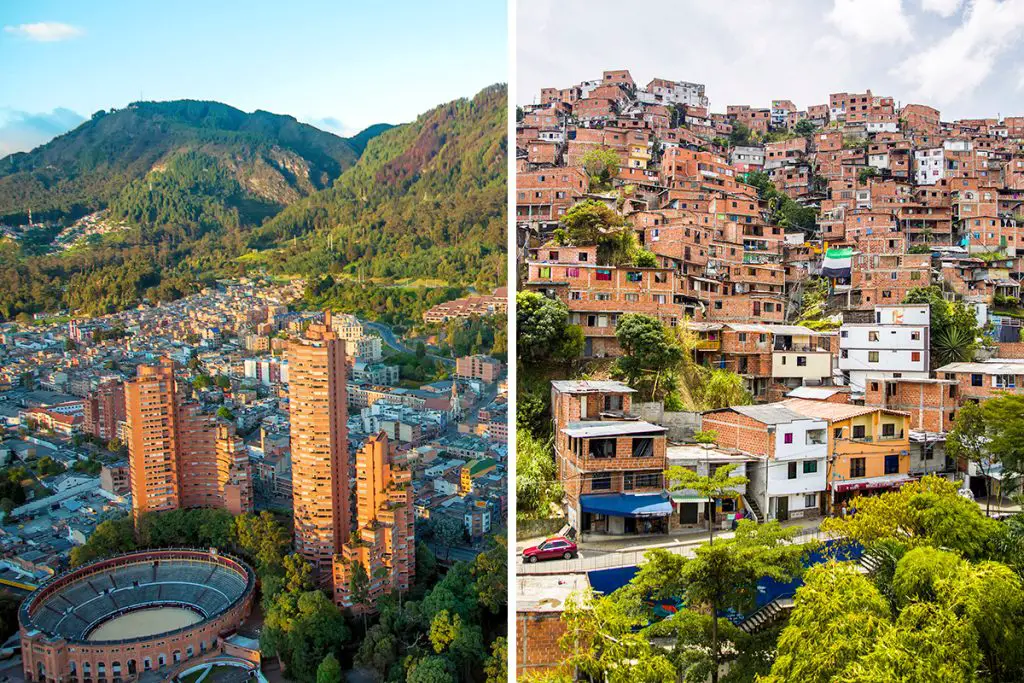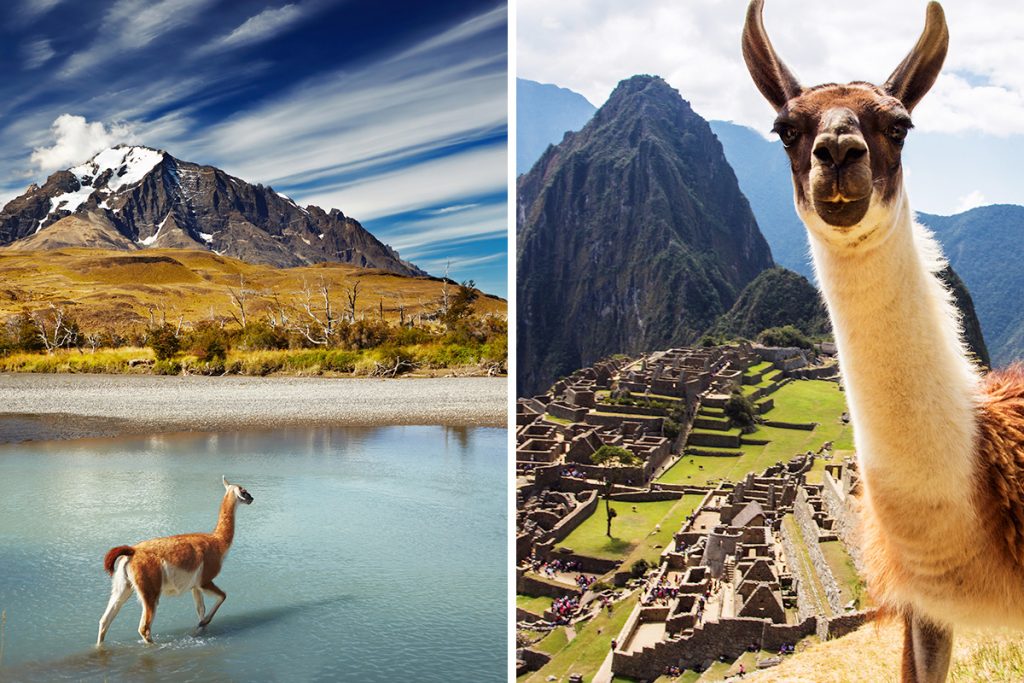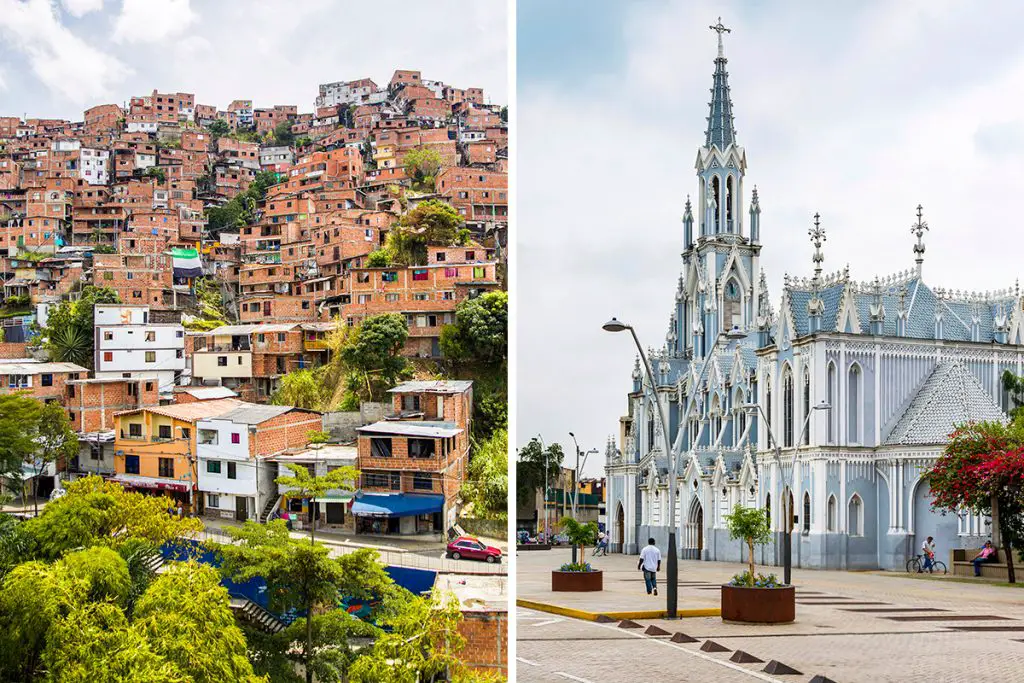The tug-of-war between Lima and Bogota is a tantalizing dance of history, culture, and urban charm. Each city has a unique way of narrating the tales of its past, offering you a different lens through which to view the rich tapestry of South American culture. Ready to delve deeper into what sets these two captivating cities apart?
History & Culture
Diving into the history and culture of Lima and Bogota is akin to flipping through pages of a living, breathing book. Each city holds onto its past, showcasing it through the veins of the modern metropolis.
Lima, often dubbed the “City of Kings”, is a living testament to a rich pre-Colombian history. The echoes of ancient civilizations reverberate through its streets, mingling with Spanish colonial influences that arrived in the 16th century.
The blend of the old with the new crafts a unique narrative, offering you a chance to walk through time as you meander through Lima’s historical core.
On the other hand, Bogota, the heart of Colombia, presents a different yet equally enthralling tale. Its history is a lively fusion of pre-Colombian cultures and Spanish colonial impressions, much like Lima.
However, Bogota has a distinctive flair in showcasing its history, where the colonial architecture seamlessly blends with modern urban landscapes. The vibe is a bit more contemporary, with a pulse that beats to the rhythm of modern-day adventures intertwined with historical explorations.
The dance between the old and new in both Lima and Bogota offers a rich cultural feast. Lima’s cultural narrative is a bit more subdued but deeply rooted, offering a calm yet profound reflection of its ancient past.
Bogota’s culture, on the other hand, is like a colorful mural, vibrant and continually evolving, reflecting a modern ethos while paying homage to its historical roots.
Summing up, your journey through the historical and cultural lanes of Lima and Bogota is bound to be an enriching experience. Each city offers a unique glimpse into the past while engaging with the present, promising a treasure trove of stories waiting to be uncovered. The choice between the serene historical charm of Lima and the vibrant cultural pulse of Bogota is indeed a delightful dilemma, awaiting your exploration.
Attractions & Activities
Venturing into the heart of Lima and Bogota unveils a banquet of attractions and activities, each telling tales of a rich cultural past and a vibrant, energetic present. The cities, though rooted in history, offer a plethora of experiences that make your journey an endless exploration.
In Lima, the ancient whispers among the ruins of Pachacamac invite you for a day of historical exploration. This archaeological site, a mere 31.07 miles (50 km) from Lima’s heart, unveils the mystery of the ancient Inca and pre-Inca cultures.
Similarly, the grandeur of Plaza de Armas with its monumental architecture captivates any history enthusiast. The quiet hum of history is more palpable as you stroll through the cobblestone streets, unearthing tales of bygone eras.
Conversely, Bogota boasts a different kind of allure. The towering Monserrate Mountain stands as a guardian over the city, and a trek up its trails rewards you with panoramic vistas of Bogota’s sprawling urban landscape.
Furthermore, the historical neighborhood of La Candelaria offers a blend of cultural exploration with its quaint colonial buildings, yet it also opens doors to adventurous urban explorations.
As you steer away from the historical and venture into the creative, Lima’s MATE – Mario Testino Museum is a haven for art enthusiasts. It’s where contemporary art finds a voice amidst the ancient whispers of the city.
Meanwhile, in Bogota, the graffiti tour through the city streets is a canvas displaying Colombia’s social and political narrative, offering a different kind of creative expression.
In conclusion, the array of attractions and activities in Lima and Bogota provide a diverse palette of experiences. While Lima lures with a calm historical charm, Bogota vibrates with a blend of the old and the new, each promising a unique adventure. Your penchant for history, art, or urban exploration will find a home in either of these South American gems, paving the way for unforgettable memories.
Beaches
The coastal allure of Lima and the distant beaches from Bogota offer contrasting beach experiences. These destinations, each with its own unique coastal charm, provide different windows to embrace the ocean’s grandeur.
Lima, being a coastal city, naturally has a closer proximity to beaches. The rocky shores of Miraflores, a district in Lima, are just a stone’s throw away from the city center. The Pacific Ocean hugs the city, and the cool sea breeze is a constant companion as you explore the urban landscape.
The beaches here might not have the soft sand typical of tropical paradises, but they have a rugged charm that beckons.
On the flip side, Bogota sits nestled in the Andean region, far from the coastline. The nearest beach requires a journey of around 296.5 miles (477 km) to reach Cartagena, a city known for its beautiful Caribbean beaches.
Though not a direct part of Bogota’s landscape, the accessible beaches add a different flavor to the Bogota experience, should you choose to venture beyond the city.
In essence, the beach experiences when comparing Lima and Bogota are significantly different. Lima provides an immediate escape to the rocky shores, integrating the ocean into the city’s daily life. Conversely, Bogota’s beach adventures are more of an extended journey, offering a deeper exploration of Colombia’s diverse landscapes.
The choice between immediate coastal access and an adventurous trek to the seaside is yours to make, each holding promises of unique encounters with the ocean’s beauty.
Eating, Drinking & Nightlife
Delving into the culinary landscapes of Lima and Bogota unveils a realm of flavors waiting to dance on your palate. The gastronomic journey in these cities is not just about satiating hunger, but a gateway to explore their culture and traditions.
Lima, often heralded as the Gastronomic Capital of Latin America, offers a culinary scene that is a beautiful blend of tradition and innovation. From the humble cevicherias to the high-end eateries, every meal is a celebration of diverse flavors.
The city’s cuisine is a mirror of its rich cultural heritage, with a hint of influence from the Spanish, African, Chinese, and Japanese culinary traditions.
Bogota, on the other hand, brings to the table a different yet equally enticing culinary palette. The city is a haven for those keen on exploring the traditional Colombian flavors. From arepas to ajiaco, the local dishes narrate tales of the land’s history and culture.
When it comes to quenching thirst, both cities have a unique offer. Lima’s drink scene is headlined by Pisco, a grape brandy that’s the heart of many a Peruvian cocktail. Bogota, meanwhile, boasts a burgeoning craft beer scene, inviting you to explore the myriad flavors brewed within the city’s boundaries.
As night falls, the cities come alive with a different energy. Lima’s nightlife is more subdued yet elegant, with a plethora of cozy bars and lounges where the conversations flow as smoothly as the drinks. Bogota, however, buzzes with a youthful energy. The city’s nightlife is an eclectic mix of salsa clubs, modern bars, and live music venues, promising a lively night out on the town.
In summation, the gastronomic and nocturnal adventures awaiting in Lima and Bogota are as diverse as the cities themselves. Whether you’re yearning for a quiet elegant evening or a lively night on the town, a traditional meal or a modern culinary experience, your desires will find a canvas in the vibrant scenes of Lima and Bogota.
Shopping
The bustling markets and modern malls of Lima and Bogota offer a plethora of shopping experiences. Each city, with its unique blend of traditional and contemporary, unveils a different facet of its culture through the items on sale.
Lima’s markets are a treasure trove of traditional crafts, textiles, and unique Peruvian souvenirs. The Indian Market and Miraflores Artisan Market are quintessential spots where the vibrant colors of Peru come alive. Each stall tells a story, and every item holds a whisper of the rich Peruvian tradition.
On the flip side, Bogota offers a different shopping panorama. The city is known for its emeralds, and a visit to the emerald market is akin to stepping into a green sea of sparkling gems. Moreover, the local markets like Mercado de las Pulgas de Usaquen offer an array of handcrafted goods and antiques, reflecting Colombia’s artisanal heritage.
Both cities also boast modern shopping malls catering to the contemporary shopper. Lima’s Larcomar is a modern cliff-top mall offering a blend of shopping with a view, while Bogota’s Unicentro is a sprawling space housing international and local brands.
To sum up, the shopping expedition in Lima and Bogota is a journey through the modern and the traditional, the local and the international. Whether it’s the handcrafted treasures or the latest fashion trends, each city offers a distinct shopping experience that goes beyond mere retail therapy, inviting you to take home a piece of their rich cultural tapestry.
Accommodation
Finding a cozy corner to rest your head after a day of exploration is essential, and both Lima and Bogota offer a myriad of accommodation options catering to different preferences. The hospitality scene in these cities is a reflection of their cultural ethos, blending tradition with modern comforts.
In Lima, the districts of Miraflores and Barranco are popular choices for travelers. Miraflores, with its modern hotels and apartments, provides a comforting embrace of contemporary living. Barranco, on the other hand, has a bohemian vibe, and the accommodation here often has a quaint charm, reflecting the artistic spirit of the area.
Bogota’s preferred areas for stay include La Candelaria and Zona Rosa. La Candelaria, with its colonial-style accommodation, offers a rustic yet cozy experience. Zona Rosa is the hub of modernity with hotels and apartments equipped with the latest amenities, providing a stark contrast to the old-world charm of La Candelaria.
Both cities offer a range of options from luxury hotels to budget hostels. Whether you’re looking for a lavish stay or a budget-friendly option, you’ll find a place that suits your needs. The hospitality in both Lima and Bogota is warm and welcoming, making you feel at home in a foreign land.
Family-Friendliness & Children’s Activities
Exploring Lima and Bogota with family unfolds a canvas of experiences that are not only enjoyable but also educational for the young ones. The cities, with their unique offerings, ensure that the little adventurers have a gala time while learning about new cultures.
In Lima, the parks and open spaces provide a natural playground for children. The Magic Water Circuit, with its dazzling display of water fountains, is a spectacle that fascinates both young and old. The city also hosts interactive museums like the Children’s Museum of Lima, which is designed to engage young minds in a fun and educational way.
Bogota also has its share of family-friendly attractions. The Bogota Botanical Garden is a serene escape where kids can learn about the flora of Colombia. Additionally, the city’s various museums, like the Gold Museum, offer interactive exhibits that pique the curiosity of the young ones.
Both Lima and Bogota prioritize family-centric experiences, ensuring that there’s something for everyone. While Lima offers more in terms of natural open spaces, Bogota provides a blend of educational and interactive venues.
Summarizing, the family-friendliness and children’s activities in Lima and Bogota ensure a balanced blend of fun, education, and cultural exposure. Each city unfolds a different chapter of South American charm, making family adventures here nothing short of memorable.
Getting There & Getting Around
Embarking on a journey to Lima or Bogota sets the stage for a South American adventure. The ease of reaching and traversing through these cities is a part of the expedition, each offering its own set of dynamics in transportation.
To reach Lima, the Jorge Chavez International Airport serves as the main gateway, located about 7.5 miles (12 km) from the city center. It’s a hub connecting various international and domestic flights. On the other hand, Bogota is served by the El Dorado International Airport, which is situated approximately 9.3 miles (15 km) from the city center.
Both airports are well-connected to major cities around the world, making the journey to these South American gems relatively straightforward.
Once in the cities, getting around in Lima might be more inclined towards using public buses or taxis, as the Metro is limited to one line. However, the Metropolitano, a bus rapid transit system, covers a substantial part of the city, making commuting easier.
In contrast, Bogota has a more extensive network of public transportation including the TransMilenio, a rapid transit bus system, and a network of cycle lanes for those preferring a greener mode of transportation.
Both Lima and Bogota have embraced modernity in their public transportation systems, yet the essence of the cities is best captured through leisurely strolls through their historic neighborhoods.
In conclusion, the journey to and through Lima and Bogota is laden with choices. Whether soaring through the skies or navigating the cityscapes, the adventure is as much in the journey as it is in the destinations. Your South American escapade begins with a flight and continues on the roads less traveled within the heart of Lima and Bogota.
Weather
The weather can significantly impact the flavor of your adventures in Lima and Bogota. A glimpse into the climatic variations of these cities helps in aligning your travel plans with the kind of experiences you seek.
Lima, blessed with a mild desert climate, experiences little fluctuations in temperature throughout the year. The summers from December to April are pleasantly warm with temperatures ranging between 63°F to 84°F (17°C to 29°C), making it a delightful time for outdoor explorations.
However, winters from June to October are cooler and humid, with temperatures hovering around 59°F to 66°F (15°C to 19°C), accompanied by a persistent grey mist known as “garúa.”
On the other hand, Bogota, sitting at a higher altitude, boasts a subtropical highland climate.
The city has two dry seasons from December to March and July to August, with daytime temperatures averaging around 68°F (20°C). The wet seasons span April to June and September to November, where the city experiences more rainfall, yet the temperatures remain relatively steady, providing a cool climate for travelers.
While Lima offers a more stable and dry climate, Bogota experiences a mix of dry and wet seasons, with a cooler overall temperature owing to its altitude. The choice between the warm coastal climate of Lima and the cool, highland climate of Bogota adds another shade to your travel canvas.
Safety
Safety is a paramount consideration that shapes your travel experience. A comparative look at the safety dynamics of Lima and Bogota provides a clearer picture of what to expect.
Both Lima and Bogota have their share of urban safety issues common to large cities. It’s advisable to stay vigilant in crowded areas and avoid isolated spots after dark. However, the local authorities in both cities have taken measures to enhance safety for both residents and tourists.
In terms of non-crime-related safety, Lima experiences occasional tremors due to its location in a seismic zone. On the other hand, Bogota, being at a higher altitude, could pose challenges for individuals sensitive to altitude changes, requiring some acclimatization.
Both cities have well-structured emergency response systems in place to handle various situations, ensuring assistance is available when needed.
To sum up, while each city has its set of challenges, being informed and taking basic precautionary measures can contribute to a safer and more enjoyable experience in both Lima and Bogota.
Cost
The cost of exploring Lima and Bogota encompasses a spectrum of expenses from lodging and food to transportation. A comparative insight helps in budgeting your adventure accordingly.
In Lima, a basic meal at an inexpensive restaurant may cost around 16 PEN (approximately $4.50), while in Bogota, a similar meal might be around 13423 COP (approximately $3.50). The difference in food prices reflects the overall cost of living in these cities, with Lima being relatively higher.
Accommodation also presents a varied picture. A standard room in a 3-star hotel in Lima could cost around $130 per night, while in Bogota, it might cost around $110 per night.
When it comes to transportation, both cities offer a range of options. However, public transportation like buses and taxis tend to be more affordable in Bogota compared to Lima.
In conclusion, the cost of your adventure in Lima or Bogota will largely depend on your choices and preferences. While Lima may present a higher cost of living, Bogota offers a more budget-friendly alternative. Understanding the cost dynamics of each city enables you to plan a trip that aligns with your budget, without compromising on the richness of experiences awaiting in these vibrant South American cities.
Which Is Better – Lima or Bogota?
Embarking on a journey to either Lima or Bogota opens up a world filled with rich histories, diverse cultures, and an array of experiences waiting to be discovered. Your choice between these two captivating cities will hinge on your personal preferences, the nature of your adventure, and what you seek to explore and experience.
When delving into the past, Lima’s profound pre-Colombian roots intertwined with Spanish colonial influences offer a serene walk through history. Bogota, however, presents a lively historical narrative where colonial charm meets modern-day vibrancy, making it a dynamic choice for history enthusiasts.
In terms of attractions and activities, Lima’s calm yet enriching historical tours contrast with Bogota’s more energetic and adventurous offerings. The contrasting allure of serene beaches in Lima and the adventurous trek to the coast from Bogota add a different flavor to the exploratory palette of each city.
The gastronomic journey in Lima, hailed as the Gastronomic Capital of Latin America, is a celebration of diverse flavors, while Bogota offers a traditional Colombian culinary experience. The nightlife in Lima is more subdued, whereas Bogota buzzes with youthful energy, providing a lively night out on the town.
Shopping in both cities is a blend of traditional and modern, with Lima offering a window into Peru’s rich artisanal heritage and Bogota showcasing Colombia’s love for emeralds and modern fashion trends. The accommodation options in both cities cater to a wide range of preferences, from quaint, artistic corners in Lima to modern, urban living in Bogota.
Family-friendly attractions and activities in both cities ensure an enjoyable time for the young adventurers. The ease of getting around in Bogota with its extensive public transportation network contrasts with Lima’s more limited metro system, yet both cities offer unique vistas that are best explored on foot.
The weather, safety, and cost factors further delineate the choice between Lima and Bogota. Lima’s mild climate is welcoming year-round, whereas Bogota’s cool, highland climate offers a refreshing escape from the tropical heat.
In conclusion, the choice between Lima and Bogota boils down to personal preferences. Lima is a haven for those seeking a calm, historical, and coastal experience with a touch of modernity. On the other hand, Bogota is a lively, modern city with a rich historical backdrop, ideal for those seeking a more energetic and adventurous urban experience. Each city, with its unique charm and offerings, promises a memorable South American adventure awaiting your discovery.


